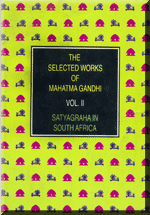
P.O. SEVAGRAM, DIST.WARDHA 442102, MS, INDIA. Phone: 91-7152-284753
FOUNDED BY MAHATMA GANDHI IN 1936
THE SELECTED WORKS OF MAHATMA GANDHI
Vol-2 : Satyagraha In South Africa

SATYAGRAHA IN SOUTH AFRICA
from
Selected Works of Mahatma Gandhi
Volume II
Written by : M. K. Gandhi
Table of Contents
- Geography
- History
- Indians Enter South Africa
- A Review of The Grievances :Natal
- A Review of The Grievances : The Transvaal and other Colonies
- A Review of The Early Struggle
- A Review of The Early Struggle : Continued
- A Review of The Early Struggle : Concluded
- The Boer War
- After The War
- The Reward of Gentleness - The Black Act
- The Advent of Satyagraha
- Satyagraha v. Passive Resistance
- Deputation To England
- Crooked Policy
- Ahmad Muhammad Kachhalia
- A Rift In The Lute
- The First Satyagrahi Prisoner
- 'Indian Opinion'
- A Series of Arrests
- The First Settlement
- Opposition and Assault
- European Support
- Further Internal Difficulties
- General Smuts' Breach of Faith(?)
- Resumption of The Struggle
- A Bonfire of Certificates
- Charge of Forcing Fresh Issues
- Sorabji Shapurji Adjania
- Sheth Daud Mahomed etc. Enter The Struggle
- Deportations
- A Second Deputation
- Tolstoy Farm-I
- Tolstoy Farm-II
- Tolstoy Farm-III
- Gokhale's Tour
- Gokhale's Tour (Concluded)
- Breach of Pledge
- When Marriage Is Not A Marriage
- Women in Jail
- A Stream of Labourers
- The Conference and After
- Crossing The Border
- The Great March
- All in Prison
- The Test
- The Beginning of The End
- The Provisional Settlement
- Letters Exchanged
- The End of The Struggle
- Conclusion
About This Book
Written by : M. K. Gandhi
Translated from the Gujarati by : Valji Govindji Desai
General Editor : Shriman Narayan
First Edition :10,000 copies, February 1959
I.S.B.N :81-7229-008-3 (Set)
Printed and Published by :Jitendra T. Desai,
Navajivan Mudranalaya,
Ahemadabad-380014
India.
© Navajivan Trust, 1968
Download
Chapter-51: Conclusion
Thus the great Satyagraha struggle closed eight years, and it appeared that the Indians in South Africa were now at peace. On July 18, 1914, I sailed from England, to meet Gokhale, on my way back to India, with mixed feelings of pleasure and regret, pleasure because I was returning home after many years and eagerly looked forward to serving the country under Gokhale’s guidance, regret because it was a great wrench for me to leave South Africa, where I had passed twenty-one years of my life sharing to the full in the sweets and bitters of human experience, and where I had realized my vocation in life.
When one considers the painful contrast between the happy ending of the Satyagraha struggle and the present condition of the Indians in South Africa, one feels for the moment as if all this suffering had gone for nothing, or is inclined to question the efficacy of Satyagraha as a solvent of the problems of mankind. Let us here consider this point for a little while. There is a law of nature that a thing can be retained by the same means by which it has been acquired. A thing acquired by violence can be retained only by truth. The Indians in South Africa, therefore, can ensure their safety today if they can wield the weapon of Satyagraha. There are no such miraculous properties in Satyagraha, that a thing acquired by truth could be retained even when truth was given up. It would not be desirable even if it was possible. If therefore the position of Indians in South Africa has now suffering deterioration, that argues the absence of Satyagrahis among them. There is no question here of finding fault with the present generation of South African Indians, but of merely stating the facts of the case. Individuals or bodies of individuals cannot borrow from others qualities, which they themselves do not possess. The Satyagrahi veterans passed away one after another. Sorabji, Kachhalia, Thambi Naidoo, Parsi Rustomji and others are no more, and they are very few now who passed through the fire of Satyagraha. The few that remain are still in the fighting line, and I have not a shadow of a doubt that they will be the saviors of the community on the day of its trial if the light of Satyagraha is burning bright within them.
Finally, the reader of these pages has seen that had it not been for this great struggle and for the untold sufferings which many Indians invited upon their devoted heads, the Indians today would have been bounded out of South Africa Nay, the victory achieved by Indians in South Africa more or less served as a shield for Indian emigrants in other parts of the British Empire, who, if they are suppressed, will be suppressed thanks to the absence of Satyagraha among themselves, and to India’s inability to protect them, and not because of any flaw in the weapon of Satyagraha.I will consider myself amply repaid if I have in these pages demonstrated with some success that Satyagraha is a priceless and matchless weapon, and that those who wield it are strangers to disappointment and defeat.